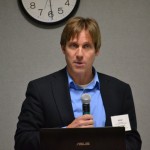Mountain Counties water districts explore small hydro options
Mountain Counties water districts explore small hydro options
By Roberta Long, MCWRA writer
Until recently, small hydroelectric projects were too expensive and permits and licensing too time-consuming for water districts to consider. Now, a number of factors are coalescing to improve the desirability of adding small hydro projects to their district operations.
On March 22, the Technical Advisory Committee of the Mountain Counties Water Resources District held a workshop to explore the benefits and impediments to construction and operation of small hydro projects. Around 50 members of the northern California water world gathered at the El Dorado Irrigation District in Placerville to consider all aspects of adding small hydro projects to existing systems.
The technology has been around since the 1890s, but significant improvements that lower construction costs continue to be made.
A major obstacle has been regulatory. Small hydro projects are usually between 10 and 30 MW capacity. Mini hydro is 100kW to 1 MW and micro is 100kW. Small hydro had the same regulatory requirements as large hydropower projects, having to meet National Environmental Protection Act (NEPA) standards and requiring a license from the Federal Energy Regulatory Commission (FERC).
Current energy policy supports small hydro as a renewable energy source with minimal environmental impacts that creates jobs, especially in the rural parts of the country. Since 2010, FERC has been simplifying its approval process. It now provides for two exemptions from licensing, subject to certain conditions. The exemptions are issued in perpetuity.
One applies to small hydro projects of 5 MW or less that will be built at an existing dam, or projects that utilize a natural water feature for head, or an existing project that has a capacity of 5 MW or less and proposes to increase capacity.
The other is a conduit exemption that would be issued for constructing a hydropower project on an existing conduit, for example, an irrigation canal. Conduit exemptions are authorized for generating capacity of 15 MW or less for non-municipal and 40 MW or less for a municipal project. The conduit cannot be primarily for power production and cannot be located on federal lands.
FERC also simplified the licensing application process. Updated permitting information is published on its website, along with templates to develop a request.
It is now possible for water districts to create new revenue to offset the costs of operation and keep water rates down.
Placer County Water Agency shares experience
Placer County Water Agency (PCWA) has four small hydro projects in play. Brent Smith, Deputy Director of Technical Services, described them.
1) The Lincoln Metering and Hydroelectric Station takes advantage of an existing plant that meters treated water delivered to the City of Lincoln. The plant is rated at 320 KW, with an annual generation of 1,739,265 KWH. It will operate with two Francis turbines. Average flow is determined at 2,400 gallons per minute (gpm) and peak flow at 10,000 gpm. Capital cost is set at $1,675,000, annual revenue at $173,200. Simple payback will take 9.7 years. Construction is expected to start in fall, with service beginning May 2014.
2) Gold Run Pipeline and Hydroelectric Station Project. Hydro is incorporated into a major pipeline replacement project on the Boardman Canal east of Colfax that provides raw water to western Placer County. A 200-foot drop creates an average head of 195 feet. Average flow is anticipated at 13.8 cubic feet per second (cfs), with peak at 26 cfs. A Crossflow turbine will be used for the hydroelectric operation, which replaces a pressure safety valve. The plant is rated at 300 KW, annual generation at 1,062,000 KWH. Capital cost is projected at $611,000, annual revenue at $116,800. Simple payback is 5.6 years.
3) Secret Town Pipeline and Hydroelectric Project. This is a future project that will replace another pipeline east of Colfax and install a crossflow turbine. A drop near the inlet will provide an average head of 198 feet. Average flow is determined to be 13.6 cfs, with 26 cfs at peak. Annual generation is expected to be 1,503,210 KWG. The plant rating is 235 KW. The capital cost is estimated at $1,671,500. With annual revenues of $186,935, the simple payback period will be 8.9 years.
Gold Run and Secret Town are in the pre-design phase.
4) Long Ravine Pipeline and Hydroelectric Station. This project involves 4,400 feet of pipeline a few miles above Colfax. The project is over 100 years old. Just upstream of the inlet structure is a 67-foot drop, and above that is another 40 feet of drop. Average head is 210 feet. More can be obtained by capturing additional drops. Average flow is 13.6cfs with a peak of 26 cfs. Other parameters are to be determined.
The power produced at the small hydro stations will be sold under contract with Pacific Gas and Electric Company.
Environmental Specialist Heather Trejo described her experience with the FERC and CEQA processes. She reported much of the FERC application was done online. It was a “smooth process.” The application was uploaded to the website.
In California, the California Environmental Quality Act (CEQA) requirements are used in place of NEPA. Under CEQA, projects under 5 MW can qualify for an exemption if they do not change the flow, temperature or dissolved oxygen of the water.
[Note: HR 267 (Cathy McMorris Rodgers, R-WA), Hydropower Regulatory Efficiency Act of 2013, and S 545 (Lisa Murkowski, (R-AK), Hydropower Improvement Act of 2013, each change the exemption from 5 MW to 10 MW.]
The exemption application for the Lincoln project was circulated on May 2012. The exemption was issued in October. Trejo said an important component of the application was stakeholder involvement. The other was perfecting the application.
As a result of their experiences, Trejo and Smith made some recommendations: Engage firms that are experienced in this specialized form of engineering. Feasibility studies should reflect actual costs. Cost estimates need to capture all costs. Specify equipment that will last. Take a long-term perspective for payback (10-20 years). Prepare to deal with private property owners.
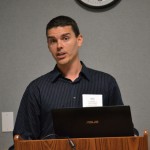 HDR considers siting, design and licensing
HDR considers siting, design and licensing
Rick Jones, P.E., HDR Managing Principal of Hydropower Services, amplified Smith’s and Trejo’s message. Jones said small hydro projects are generally co-located with other necessary infrastructure. They include drop structures in existing canal and flume systems. Small hydro can be sized up or down more easily than conventional hydro projects. Because the areas where small hydro projects might be located may be remote, access to transmission lines is an important consideration. In estimating available flows, surrogate data methods can be used in ungaged watersheds. Jones counseled making sure the water rights are protected.
Different turbines are used in different situations. Traditional technologies can be suitable. Emerging technologies are being developed for small hydro. The Natel low head system is designed to deliver low cost baseload power. The Reverse Archimedes Screw is a variation on a technology in use more than 22 centuries ago.
For a small hydro exemption, the powerhouse must be less than 500 feet from the existing dam, and more than 36 percent of head must be provided by the dam. The applicant must own all lands needed for construction, operation and maintenance. The project must not affect threatened and endangered species or need fish passage.
Jones said that one of the trends pushing development of small hydro is the Renewables Portfolio Standard (RPS). In California, this program requires investor-owned utilities and others to procure at least 33 percent from eligible renewable energy resources by 2020. With an RPS certification, producers can earn Renewable Energy Credits that can be sold.
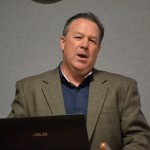 A message from Ron Skaggs, P.E., G.E., self-described “dirt guy”
A message from Ron Skaggs, P.E., G.E., self-described “dirt guy”
Ron Skaggs is Vice President and Principal Engineer of Condor Earth Technologies. As a licensed civil and geotechnical engineer and general engineering contractor, he has worked on existing and historic water resource projects in the central Sierra Nevada.
Skaggs made the argument for investing in subsurface investigation:
•Better quality subsurface information leads to better facility design.
•Fewer unknowns lead to better quality bids.
•Better baseline data leads to more defensible positioning and better claim risk management.
•Better-known conditions lead to more predictable outcomes.
The Sierra Nevada presents a mixture of varying types of subsurface materials in proximity with one another. Geotechnical engineering can save money and provide increased confidence in the project design and operation.
 NLine Energy is local small hydroelectric provider
NLine Energy is local small hydroelectric provider
NLine Energy is located in the Sierra Nevada foothills in El Dorado Hills. Founder and CEO Matt Swindler said the company provides in-conduit hydroelectric renewable power generation. Typical water distribution transmission systems are subject to over-pressurization at points along the lines, creating inefficiencies. NLines’ Water to Energy Recovery Systems can be installed to capture wasted energy at pressure relief valve sites. The renewable electricity can be used on site or sold to a utility.
Federal grants and loans are available from the Department of Energy, U.S. Treasury Investment Tax Credit/Production Tax Credit, Bureau of Reclamation and U.S. Department of Agriculture.
California offers grants and subsidies through the Self-Generation Incentive Program, California Energy Commission Electric Program Investment Charge, and Department of Water Resources. Some local areas provide financial assistance.
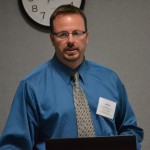 El Dorado Irrigation District investigates small hydro opportunities
El Dorado Irrigation District investigates small hydro opportunities
Brian Mueller, P.E., EID Director of Engineering, said the district has been checking out possible small hydro projects since 2008. In 2009 EID identified four sites and selected two for further study: Tank 7 on Pleasant Valley Road at Diamond Springs and Tank 3 at El Dorado.
Action on the Tank 3 project was halted when it was determined the site is located on Forest Service land and therefore not exempt from the FERC licensing process. The district is monitoring legislation that could ease this requirement.
Tank 7 is an in-conduit hydroelectric generation system. It advanced to 30 percent design. EID filed an application for a CEQA exemption, obtained a FERC license exemption., and applied for a PG&D feed-in tariff. Feed-in tariffs provide a simple method for small renewable generators to sell power to the utility at predefined terms and conditions, without engaging in drawn-out contract negotiations. Feed-in tariffs apply to purchase of up to 480 MW of renewable generating capacity from renewable facilities smaller than 1.5 MW.
As the design developed, project cost estimates and payback increased beyond the initial feasibility estimates. Work was put on hold pending improved pricing and incentives.
In 2012, EID re-examined the project. Flow and pressure data was expanded and updated. Overall station design was reviewed. Power generation and value-engineering estimates were analyzed. Financing alternatives and revenue projections were evaluated. FERC granted a two-year extension for the conduit part of the project.
The updated project is a three-turbine, 370 kW design. When it is operational, it will be eligible for the Renewable Energy Self-Generation Bill Credit Transfer program under Proposition 84. The additional revenue stream will offset operating costs. Over a 30-year period, staff estimates $4 to $5 million could be gained.
EID applied for two sources of grant funding. The El Dorado County Water Agency approved EID’s application for cost-sharing of engineering design services on April 10. The Water Agency approved a $41,870 share until the end of the fiscal year, June 30. The Water agency also approved a draft budget for 2013-14, which includes an additional $186,000 cost-share for engineering design of the project.
The second request is for $400,000 toward construction expenses under the Cosumnes-American-Bear-Yuba Integrated Regional Water Management Plan. A decision is expected in fall 2013.
On March 11, the EID board approved a single-source, or “turnkey,” professional services contract to NLine Energy in the amount of $400,170, and authorized total funding of $550,170 for the design phase.
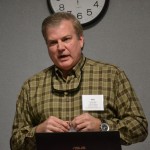 Start with the basics – Ken Fonnesbeck
Start with the basics – Ken Fonnesbeck
Ken Fonnesbeck, P.E. leads Mead & Hunt’s hydro design group. He recommends starting an evaluation of a retrofit or upgrade of an existing hydroelectric facility with a strong baseline. Ask, “What was the basis of the original design?” Develop a good understanding of head and flow characteristics and the basis for conduit and unit sizing, he said.
Other questions: Are there different seasonal flow constraints, different minimum releases, different ramping rates (rate of change of water flow through turbines at hydroelectric facilities)? Does the project have an impact on rare, threatened or endangered species? Is performance degraded due to worn-out equipment or other reasons?
It may be useful to have a utility representative involved at the beginning.
Decisions should balance the costs of providing for projected water demands vs. the cost of decommissioning. Any project may invite challenges to water rights. Water rights need to be clear and unambiguous.
The water industry is facing changing regulatory and licensing requirements that may require higher and faster ramping rates, resulting in less overall water for generation. Higher instream flow releases are likely to be required to satisfy a range of demands. Higher instream flow releases may cause turbines and generators to run out of optimum range.
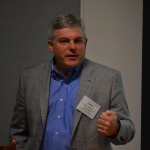 Joe Domenichelli, P.E., a cautious optomist
Joe Domenichelli, P.E., a cautious optomist
As President of Domenichelli & Associates, in El Dorado Hills, Domenichelli has been tracking the recent incentives and financing options for small hydro projects on the one hand. On the other hand, he is watching the changing regulatory dynamics. “The environment continues to change and evolve in the areas of renewable energies, making projects more feasible,” he said.
Knowledge of the local grid is important. Interconnections can be a “black hole,” costing 30-50 percent of a project, he warned.
“Follow the money,” he counseled. When planning a small hydro project: “Get it right. Use it wisely. Reduce surprises.”
The workshop was underwritten by Condor Earth Technologies, Inc., Placer County Water Agency, HDR, El Dorado County Water Agency, NLine Energy, Inc., El Dorado Irrigation District, and Mead & Hunt.
For more information about Mountain Counties Water Resources Association, visit www.mountaincountieswater.com, or call 530-957-7879.
